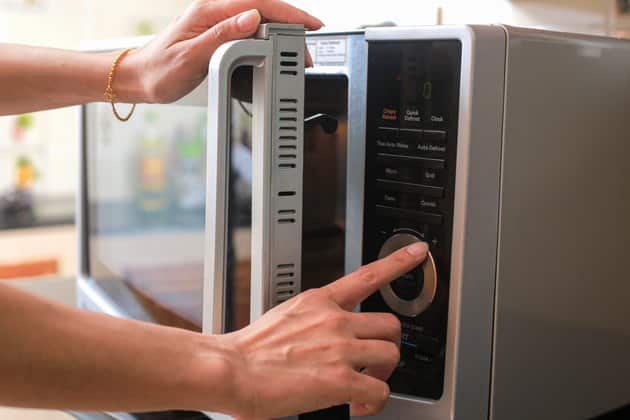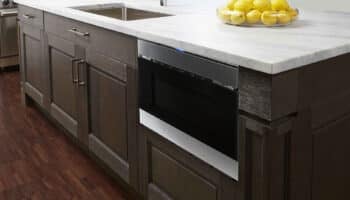Are you trying to figure out how to use your microwave grill combo?
Welcome to the club! While everyone can use a microwave, a microwave grill is a little harder to understand.
Don’t worry, though. You came to the right place for answers.
Below, I’ll show you how to use your microwave grill properly. I’m sure that by the end of it, you’ll be an expert in every setting and option your manufacturer has built into the appliance.
Read on to make the most out of your microwave grill!
While the instructions detailed below should apply to almost any microwave, it’s important to double-check with your unit’s specific manual.
Lost yours? No worries.
Check out our guide to finding any product’s manual online:
Ever wondered how a microwave works or what type is best for your kitchen? Check out our full guide on microwaves.
Using a Grill Microwave

Having a grill in your microwave offers a whole new level of convenience, so a microwave grill can be a great addition to your kitchen if you’re in the market for one. But sometimes, it also adds a bit too much complexity.
Many users get stuck on operating the microwave properly, especially between ‘grill only’ or ‘combi’ options. Thankfully, these are almost always the same on most models. Get ready to learn all about microwave grilling techniques.
To Use Only Your Microwave Grill:
- Hit the ‘Grill’ button: Typically, it’s 1, 2, or 3 presses for low, medium, and high power.
- Use the dial to select the grilling time.
- Press ‘Timer’ if you want to add any standing time.
- Close the door (unlike your oven grill, the door needs to be closed).
- Press start.
To Use the ‘Combination’ Mode:
- Hit the ‘Combi’ button to select the setting. Check your user manual or stickers on the microwave for guides. Typically, the settings are low, medium, and high. The grill microwave power is either going to be low or medium.
- Use the dial to select the cooking time.
- Press ‘Timer’ if you want to add any standing time.
- Close the door.
- Press start.
Not Sure Which Setting Is Grill Only?
Don’t worry; there’s a quick test we can use to find out.
- Take a microwavable jug or container, and fill it with water.
- Place it in the microwave, and run it on standard microwave power for a few minutes.
- When you test the water, it should be plenty warm.
- Do the same again, but use the ‘Grill’ setting.
- After a few minutes, the water should be much cooler than before. If it’s the same temperature (or similar), then the microwave is also likely on at the same time.
How to Cook Meat and Veggies in Your Microwave Grill
Now that you’re an expert in how to use a microwave grill combo, let’s quickly cover how you can grill meats and veggies in your appliance.
Grilling meat in your microwave grill:
- Choose a mouth-watering cut of meat from your nearest butcher shop.
- Season to taste, and place the cut of meat inside your microwave grill.
- Choose the “Grill” Mode on your microwave grill. The specific instructions on how to set Grill Mode, what power level to choose, and how long to leave the cut of meat cooking should all be in your User Manual.
- Once you’ve set your preferred configurations, start the cooking cycle.
- Stop the microwave grill halfway through, put on oven gloves, and flip the meat over so the other side cooks uniformly.
- Once the preset time is done, remove the cut of meat and leave it to rest for about 15 minutes before cutting.
- Enjoy!
Grilling veggies in your microwave grill:
- Wash and chop your veggies.
- Place them in a cooking dish and let the dish rest inside your microwave grill, on the rack.
- Make sure the veggies are spread out evenly to ensure uniform cooking.
- Check your User Manual to find the recommended settings for grilling different types of veggies.
- Press “Start” and wait for the cooking process to be completed.
- Bon Appétit.
What Utensils Can You Use with a Microwave Grill?
It’s important to have a quick think about what exactly you’ll be putting in your microwave grill. First off, let’s do a quick run-through of things you should never put in the microwave:
- Aluminum foil: Aluminum foil reflects the microwaves causing plenty of sparks.
- Wire twist: Like aluminum, wire twists can cause arcing (tons of blue light).
- Recycled paper: (i.e., Kitchen Roll). Unless stated as microwave-safe, recycled paper can include recycled materials that could ignite and cause sparks, so I recommend using it with caution.
- Plastic Bags/Containers: If branded as microwave-safe, plastic is fine, but unsafe plastic will melt and release harmful chemicals.
- Most things without a lid: We’ve all seen a messy microwave. Try to make sure food is always covered but not airtight.
Those are the basics. But what about with a grill?
When you’re using the grill, we also need to make sure that:
- Everything’s heatproof. Microwave-safe goods are safe because they don’t heat up in a microwave. However, microwave-safe goods will heat up and melt when placed under a hot grill, and this includes many microwave-safe plastics. Ensure you have something like Pyrex that will withstand the heat.
- Don’t cover anything. Since the heat is being applied directly from the back, covering anything with a lid will cause it to cook unevenly! If you’re using a “combi” setting, this is the reason the combination mode doesn’t go above ‘medium’ microwave power, as it would cause a huge mess.
Want to Find Out if Something’s Safe?
An easy test to find out if a utensil or plate is microwave-safe is to compare it with a proven microwavable tool.
Here’s how it works:
- Place a microwave-safe jug half-filled with water inside the microwave.
- Put in the dishes or utensils you want to test.
- Run the microwave on full power for 2–3 minutes.
- Feel the water jug. Is it warm? Good – the microwave works!
- Now feel the utensils and dishes.
- If the utensils and dishes are still cool, they’re not absorbing the microwave energy and are safe.
- If utensils and dishes are warm or hot, they should not be used in the microwave!
Best Practices
Microwave grills haven’t been around long, so their best practices aren’t always well known. Thankfully, there’s handy internet guides like this one to help.
- Place a heatproof plate underneath if you’re grilling with a wire rack. Grilling typically creates a bit of grease splatter, which we don’t want to be left in the microwave.
- Don’t use the ‘Combi’ setting for small portion sizes. It’s simply too much for a small amount of food. Just use the grill instead.
- Never cover foods while grilling. It can be an easy mistake to make when we’re used to microwaving covered dishes.
- Stay away from the exterior! When grilling, the microwave grill’s exterior may get super hot – especially around the air vents, as opposed to standard microwaves, which tend to keep heat inside.
- Allow standing time if microwaving. Microwaves can cause some areas to be super hot while others remain cold. In my experience, a few minutes of standing time allows heat to spread out, ensuring the food is a continuously delicious level of hot.
- Clean regularly. Leftover food or grease can get re-cooked and start to smoke (or smell horrible!). For an easy, deep clean, place a liter of water in with a few tablespoons of lemon juice. Microwave on high for 10–15 minutes. The lemony water vapor will loosen up any dirt and grime, allowing you to wipe it away with a cloth.
Conclusion
Figuring out how to use a microwave grill is a great advantage, but unfortunately, it doesn’t come without its fair share of challenges.
I hope this guide has helped you better understand how you can get the most out of your appliance while staying safe and avoiding putting in materials that can be dangerous or incompatible.
Thank you very much for sticking with me all the way to the end. If this article piqued your interest and answered your most burning questions, please check out our other incredible resources below and consider subscribing to our newsletter.
I hope you have a wonderful rest of the week!
-Craig.








